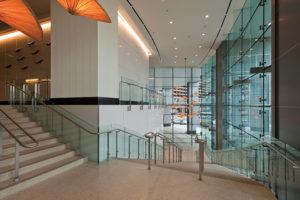What started out as a differentiator has now become a normal part of doing business. Dual-branded hotels are on the rise in markets across the country—from suburban to urban. But while the operational efficiencies and the ability to cross-market guests make this kind of property an appealing option for developers and owners, dual-branded hotels do present distinct design challenges.
According to Keith Simmel, principal at Atlanta-based architecture and design firm Cooper Carry, the company has completed quite a number of dual-branded hotels within the last 10 years; the hospitality division at Cooper Carry has built nearly 10 and has a few under construction. Recent dual-brand builds for Cooper Carry include Hyatt Place and Hyatt House in Charleston, SC; Courtyard by Marriott and Residence Inn located in the Lake Nona district of Orlando, FL; and the AC Hotel and Moxy in Midtown Atlanta, which will be completed soon.
Simmel said the rising interest in this type of project can be attributed to rising land costs; the ability of different hotel brands to get into certain markets and right-sizing each for the location; and combining forces with brands to help them achieve their financial goals, while also opening up different market sectors within the same real estate market.
Whether a dual-branded property—or even triple, for that matter—it can be a complicated project from both a design standpoint and a business one. “We have completed a few studies where we had four brands under the same roof. It was a speculative high-rise project in upstate New York. For some reason, it didn’t go forward, but the developer was very interested in marrying-up four different companies,” recalled Simmel.
And, even with just two brands, these projects pose challenges for the designer, who must make sure the brand promise is delivered for both. Simmel explained, “When designing a lobby to serve two different brands, we have to be somewhat brand agnostic. We try to be as ‘neutral’ as possible with a simple, well-organized and executed space so that the guest of either brand feels comfortable and, in some ways, can project their own expectations of the brand into the space.”
Still, that doesn’t mean there are no hurdles. He continued, “Of course, the challenge with this approach is that you run the risk of losing any identity at all, so that the space feels too bland. Working with great interior designers, owners and brand team members helps us mitigate these pitfalls and develop a space that contributes to the overall guest experience.”
One way to fend off a lack of identity is to keep location in mind. When it comes to designing lobbies, Cooper Carry doesn’t just put a picture of New York City in a hotel in Manhattan. “We look at the location within a city. We take our design cues from the region instead of a preconceived notion of what the building should look like,” Simmel said.
In Charleston, SC, Cooper Carry really examined the southern city and spent time studying the way it was developed, creating a Hyatt Place and Hyatt House responsive to the location. “In the context the building was built, we designed a modern interpretation of the Charleston row houses. The use of stucco and brick was important to us,” Simmel said. Covered outdoor space is also put into play because most of the year in South Carolina—especially in the coastal city—is hot and humid. Thus, Cooper Carry brought that design element into the hotel and brought it into the building through the use of architectural tiers and dividing the space so that rooms flow into each other, but are also well defined with plenty of light.
Another potential pitfall with dual-branded lobbies is confusing the guests on where to go throughout the arrival experience. Some hotels, such as the AC Hotel and Moxy in Atlanta, have two separate entrances; there, the front desks and the hotels join up in the middle with an elevated pool deck, bar and other shared amenities. “On the flip side, the Courtyard by Marriott and Residence Inn in Lake Nona has a single point of entry, a single desk and single elevator. Only in the guestroom where it is brand standard do guests know whether they’re in a Courtyard or Residence Inn,” explained Simmel.
Dual-branded lobbies are also adopting the same open-space trend as their single-branded counterparts. “There’s the idea of activating lobbies more than you would have seen years ago. Hotels are trying to entice their guests to be in the space more. Lobbies are now more inviting and upscale. You’re not just hanging out in your hotel room; it’s a public space and you’re out meeting people,” said Simmel.
Simmel was steadfast when he explained that designing a dual-branded hotel is like “designing any kind of hotel: It’s about answering the questions and providing a service that we think we are good at.” HB


